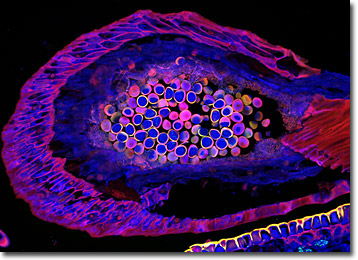 |
 |
 |
|
||||||||||||||||||||||||
 | ||||||||||||||||||||||||
 | ||||||||||||||||||||||||
 | ||||||||||||||||||||||||
Confocal Microscopy Image Gallery
Plant Tissue Autofluorescence Gallery
Cycas Sporangia
Cycas is the sole genus included in the family Cycadaceae of the order Cycadales. Members of the genus, which are subdivided into about ten different species, differ from other cycads in respect to their dark green, shiny palm-like leaves that feature a midrib but no lateral veins.

The large leaves of one of the best-known species, C. revoluta, are sometimes utilized in funerals and other ceremonies as palms, though they are much more closely related to ginkgoes and conifers than members of the family Palmae. C. revoluta is native to Japan, but is regularly grown in a variety of tropical and subtropical areas as an ornamental. The plants, which are also commonly called sago or funeral palms, can be used to produce a flour-like material by properly processing the pith contained in their stems. Without processing, the pith and other parts of the plant are toxic.
As cycads, members of the Cycas genus are dioecious, with male and female reproductive structures found on different plants. Modified leaves on male plants termed microsporophylls are the sites of pollen production. In other cycads, the microsporophylls are arranged into strobili, but the Cycas genus is unique from them in that their microsporophylls are organized into a few spiral-like configurations at the apex of the stem rather than into a cone. Hundreds of small pollen sacs called microsporangia are located on the undersides of the microsporophylls. When the microsporangia are mature, their pollen is released so that it can be carried by wind or insects to female plants.
Contributing Authors
Nathan S. Claxton, Shannon H. Neaves, and Michael W. Davidson - National High Magnetic Field Laboratory, 1800 East Paul Dirac Dr., The Florida State University, Tallahassee, Florida, 32310.
